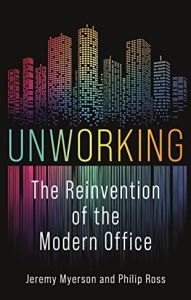Join getAbstract to access the summary!

Join getAbstract to access the summary!
Jeremy Myerson and Philip Ross
Unworking
The Reinvention of the Modern Office
Reaktion, 2022
What's inside?
As work rapidly changes, Unworking prepares readers for a profound shift in the role of the office.
Recommendation
While the offices of large corporations may look serene on the surface, underneath they are struggling to adapt. Workers are fed up with rigid, hostile workplace structures. What will a workplace adapted to the opportunities and challenges of the new world of work look like? Jeremy Myerson and Philip Ross analyze the shifting role of the office since the early 20th century, and speculate on its ongoing evolution. This part-historical, part-exploratory study will appeal to anyone preparing for the future of the workplace, either as a user or provider of the office as a service.
Summary
About the Authors
Jeremy Myerson is Professor Emeritus at the Royal College of Art in London, and futurist Philip Ross, current CEO of Ungroup, founded Cordless and the Worktech Academy. Together, they wrote three books: The Creative Office; The 21st Century Office; and Space to Work: New Office Design.



















Comment on this summary